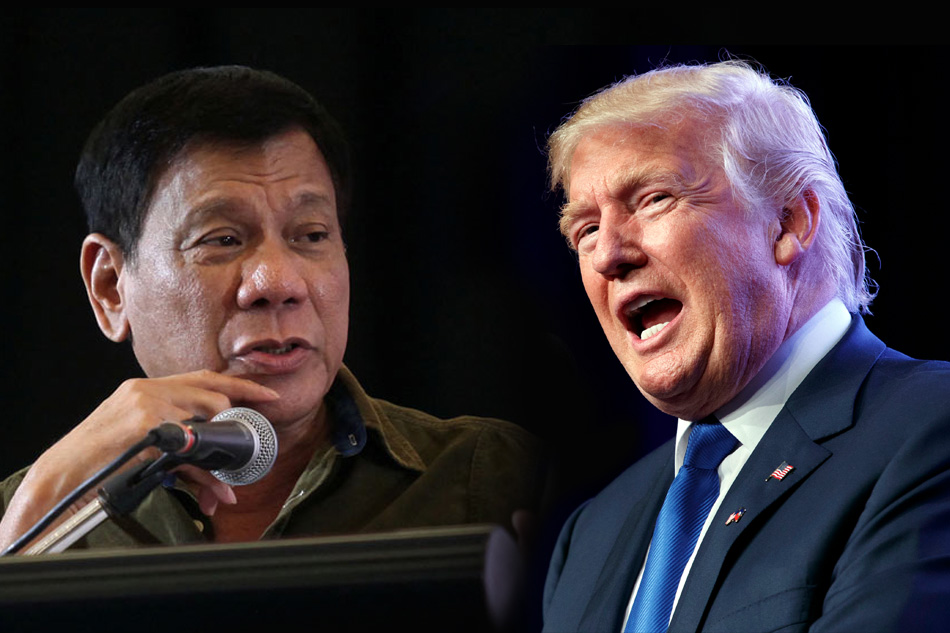Where next for the US in the Philippines, Southeast Asia

President Donald Trump and President Rodrigo Duterte will meet for the first time this year. File
(First published June 30, 4:42 p.m.) The Stratbase ADR Institute welcomed Walter Lohman for a roundtable discussion on changes in US policy in Asia on Tuesday. Lohman is the director of the Asian Studies Center at the Heritage Foundation, a well-known think tank based in Washington, D. C.
In recent months, Heritage has been in the spotlight for its reported relationship with the Trump administration. For this reason, we looked forward to hearing Lohman’s views on the direction that the White House will take next.
Watching the United States—specifically the White House—has long been important for one main reason: that the decisions made in Washington could reverberate worldwide, leaving countries and businesses to adjust their strategies to the windows of opportunity that open or shut depending on changes in US policy.
No less true today, the US has been especially entertaining (and at times, troubling) since the election of Donald Trump, who has been more of a wildcard and less of a predictable partner for Asia.
What to expect from the United States
In Lohman’s view, the United States will maintain its fundamentals in Asia, even though its eventual policy may resemble less of former president Obama’s initiatives and more those of former president Bush. In that vein, the Trump-led government could take an approach that focuses on US allies, especially in the Northeast, with Japan and South Korea, but also with Thailand and the Philippines.
An alliance-centric focus, could mean a shift away from a “neighbourhood”-type approach to world relations, replacing it with one that is defense-oriented and focuses on “teams.”
Watching to see if this shift becomes reality will be especially important for Southeast Asia, which, through ASEAN, promotes whole-of-region perspectives, using its centrality as a cornerstone for how it approaches diplomacy. This perspective may be lost on some in United States—as Lohman points out, US policy in Southeast Asia is usually derivative of its overall approach to Asia.
Washington’s priorities in our region will likely reflect what it prioritizes beyond it. As one example, Southeast Asia has been seen as a possible source of support for US efforts on the Korean Peninsula. This observation jives with the phone call between President Donald Trump and President Rodrigo Duterte, wherein they discussed the situation with North Korea.
This may not be encouraging, however, for Southeast Asian countries hoping that the region’s interests can help to shape the US agenda. Possible flashpoints that some consider to be geographically contained to our part of the world, such as the South China Sea disputes, may become less important from Washington’s perspective. Such a concern may reduce over time if the United States shows some continuity in practice.
In May, for example, US warships conducted a Freedom of Navigation operation within 12 miles of Mischief Reef, an important way for the country to show the real-life effects of the Arbitral Tribunal’s ruling in The Hague last year.
Pitfalls in trade
The main pitfall in US diplomacy is its pull-back on trade. As one guest observed during our roundtable, if you are missing on trade in Southeast Asia, you are missing 75 percent of the picture.
Our countries continue to prioritize the development of economic relations with each other and, together, a closer integration with the world economy.
If the United States is absent, Southeast Asia’s focus will be on other partners—especially China—who can help the region with that objective. As it is, the negotiations for the Regional Comprehensive Economic Partnership, centered around ASEAN, are set to be completed within the year.
US-Philippines relations
There was some debate over how the US-Philippines relationship could improve, considering the dynamic situations in place here in Manila and in Washington.
For the United States, there is a continuing interest in seeing how the Philippines could regain its leadership role in promoting the rule of law in the South China Sea, which observers had come to expect under the Aquino administration. Such a role is important given that it does not appear as though any other country in Southeast Asia would be interested in taking the lead.
Of course, many in Manila might question whether the United States would back us up in a worst-case scenario, a doubt that existed even during the Aquino years and has not dissipated under this government.
This is a chicken-and-egg situation that boils down to trust. If both sides are interested in “patching up” the divides of 2016, they may wish to start by keeping open minds to continuing engagement, to learn and re-learn the way the other end operates.
For Lohman, he believes that more people in the United States are re-setting their views and being more respectful of the way in which the Philippines conducts its foreign policy.
In this way, the US is beginning to make adjustments to its approach here, as well as it is doing in Thailand and South Korea. Such adjustments would be a welcome sign for all who want US-Philippines ties to maintain their strength.
This will be something to pay attention to as we look forward to Trump and Duterte’s first meeting later this year.
Dindo Manhit is the president of think tank Stratbase Albert del Rosario Institute, a partner of Philstar.com.
- Latest




























